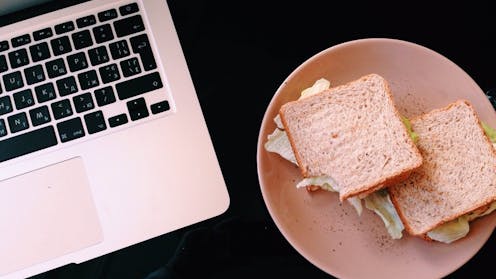Source: The Conversation – Africa – By Tinashe Mushakavanhu, Assistant Professor, Harvard University
At the Boston waterfront sits the Institute of Contemporary Art, an architectural marvel that gleams against the harbour in a wealthy neighbourhood. My Uber driver, an African immigrant, remarks as I get out: “Be careful, this is an expensive area.” His comment hints at the subtle tensions of race and class in such affluent spaces, where one’s presence as an outsider is immediately registered. I assure him I’ve just come to see the art.
I’d come to see Zimbabwean artist Portia Zvavahera’s first solo museum show in the US, Hidden Battles/Hondo Dzakavanzika. This exhibition is a landmark moment of recognition for one of southern Africa’s leading contemporary artists.
When most artists are grappling with history and archives, Zvavahera is focused on the dreams she has in her sleep, not as a retreat from the past or the urgency of the now, but as a parallel form of knowledge.
As a scholar of African literary histories and archives and how they intersect with visual culture, I find Zvavahera’s work particularly powerful. It uncovers layers of meaning that operate at the subconscious, where personal memory, cultural narratives, and the imagination intersect.
From an archival perspective, the exhibition is compelling because it frames these dreamscapes with materiality – paint, paper, canvas, brushstrokes – making each a document of emotional and cultural knowledge.
Read more:
Five artists, five nations: taking to the road to find southern Africa’s hidden stories
Zvavahera engages deeply with the traditional spirituality and African Pentecostal beliefs in which she was raised. She illuminates spirits and revelations. But she alters these dreams with emancipatory gestures: drawing in bodily features, concealing them as they morph into animal-like figures or plants. When looking closely, it’s as if the canvas was cut then sutured back with careful stitches, with each move a restoration of dignity. This is the delicacy of her brushstrokes.
The Boston gallery positions itself as a site for amplifying singular global voices in art, like Zvavahera’s. Her refusal to translate dreams into rational explanation is central to her practice. Boston audiences encounter Zimbabwean perspectives not as illustrative or ethnographic, but as intellectually and aesthetically complex. Zvavahera is placed within transnational conversations while her particular lived experiences are preserved.
The work on the show was made between 2021 and 2025, a time filled with mourning and melancholy, during and after the COVID pandemic. Zvavahera is a prophet who uses the canvas to transform dark dreams into vivid, colourful prayers. She says:
People say their prayers with words, and I’m saying my prayers with a painting.
Who is Portia Zvavahera?
Born in Harare in 1985, Zvavahera channels childhood experiences, ancestral presence, and mystical narratives into her paintings. The work blurs the line between the figurative and the abstract.
Growing up in Harare’s art scene, both modernist and indigenous art inspired her practice. She found mentorship and support from Gallery Delta and formal training from the National Gallery of Zimbabwe.
Her work has earned awards and international acclaim for its emotive force and poetic intensity.
The exhibition
Zvavahera’s canvases are layered with pigment and texture, incorporating printmaking techniques alongside stencilling, delicate lace, batik wax, and even palm fronds from her garden.
The dream paintings on show are all vast in scale, almost overwhelming in their presence. They appear as recurring visions, or fragments from a psyche as troubled as it is fertile.
The imagery conjures a world of vulnerability. Spectres in her dreams besiege her and try to snatch her children, harm her body, make her grandmother sick, unsettle her spirit. But she does not succumb. Instead, she renders them into haunting paintings and drawings, binding them into linen, oil and ink.
Their titles draw from Shona proverbs and folktales. Kurwira vana (fighting for the children). Tinosvetuka rusvingo (jumping over the wall). Hondo yakatarisana naambuya (the battle that grandmother is facing). They aren’t simply explanatory notes but portals, resisting simplification, pulling the viewer into the language of a cosmology not easily domesticated by English.
Zvavahera is an artist of scale, but also of duration. The canvases demand that viewers linger. To stand before the work is to enter a meditative space, one where line and colour pulse with life. In one caption she writes:
I know there’s going to be a battle in the future when I see a bull in my dreams.
The bull, like the angelic and demonic figures in her work, are not allegory but omen, a herald of struggle. This is the artist’s autobiography in colour.
What haunts is not only the possibility of harm, but also the persistence of love. Viewers witness the artist’s insistent refusal to let her children, her spirit, her imagination, be taken over. To dream is to fight; to paint is to protect. Her canvases stage encounters between the forces of good and evil, and transform them into visions of resilience.
Running through this series is a mystical or magical impulse that is especially vivid in her characters. Her paintings and drawings develop a kind of surrealist mystic experience.
Zvavahera’s work matters because it demonstrates how art can navigate the intimate and the ancestral, the personal and the collective. It offers a worldview that’s too often marginalised in art world conversations. She brings to the fore the depth of the African imagination.
Read more:
5 indie art spaces in African cities worth knowing more about
Her show is testament to the fact that African artists are not only present on the global art stage, they’re also helping shape the questions, forms and languages of art itself.
![]()
Tinashe Mushakavanhu does not work for, consult, own shares in or receive funding from any company or organisation that would benefit from this article, and has disclosed no relevant affiliations beyond their academic appointment.
– ref. Zimbabwean artist Portia Zvavahera turns her prayers into paintings – https://theconversation.com/zimbabwean-artist-portia-zvavahera-turns-her-prayers-into-paintings-265213

